Upon selling Walden, a 1987 Ericson 38-200 sailing sloop, and moving from South Florida to Annapolis, MD, it was time for a new (used) boat. Both Walden and our previous boat, a 30-foot Sea Ray, had sucked much of the joy out of boating due to the litany of repairs, maintenance, and necessary modernizations that I had to perform on them. Although, I will say that these two troublesome boats provided ample and fruitful fodder for numerous articles, so I suppose there is a silver lining.
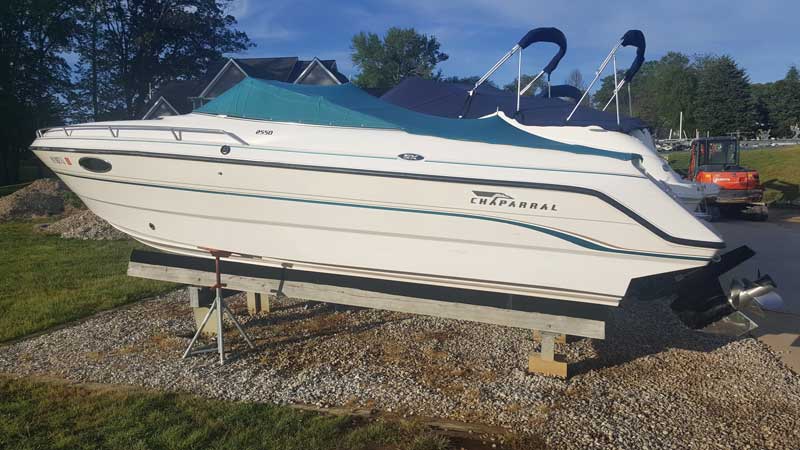
Nonetheless, after enjoying a few months’ reprieve that was exacerbated by Covid-19 lockdowns, it was time to jump back in during the lost summer of 2020. Arriving in Annapolis in January, I began perusing online classifieds all over the eastern seaboard for a particular elusive model of boat that I had always dreamed of owning but had never been able to locate and secure.
As a kid growing up in South Florida, my father owned a 1989 Chaparral 2100 SX bowrider that he purchased new at the Ft. Lauderdale International Boat Show for $17,500. I loved that this sport boat featured classic and sleek ‘go-fast’ lines, while maintaining a functional and practical deck layout. However, I did not like its dated interior, carpeted plywood deck, or open bow design. Hence, my personal dream boat became its larger, closed bow brother: the 2550 SX, which makes a fine coastal runabout (due to the additional safety that a closed bow affords) and overnighter. Unlike the 2100 SX, later models of the 2550 SX cuddy cabin featured a fiberglass floor liner, a head, a small galley, and a spacious berth, perfect for sleeping two. Although I always desired to own one of these vintage sport boats, I could never find one until January of 2020, two months before bedlam was unleashed on the world.

Although I now lived in Annapolis, my dream boat was 1000 miles away in Plattsburgh, NY, which lies on the shores of Lake Champlain. As one may imagine, this made the logistics of purchasing the vessel both tenuous and tedious to iron out. To exacerbate matters, the boat was locked in storage until March—which quickly became late May after New York’s stringent Covid-19 restrictions were enacted during the Spring of 2020 and maintained into the summer months. Thus, through the Covid lockdowns, I maintained contact with the seller, before we were finally able to make the trip in late May. Before trekking north, we agreed upon a purchase price of $15,000, which included the boat, original trailer, and many extras like a full canvas enclosure, mooring cover, and cockpit cover—all contingent upon a thorough inspection and sea trial. After months of preparation, we rented a Dodge Ram 2500 diesel truck to make the trip to bring our new baby home.
The trip north was uneventful. Upon arrival we checked into a hotel for what would be a mostly sleepless night. After years of anxiously and thoroughly searching for a 2550 SX in a condition worthy of ownership (no small task for a hull design over three decades old that was only produced from 1988-1996 and in limited numbers as far as production powerboats go), the day was finally here that I would have the opportunity to lay eyes on my prize in the wild!
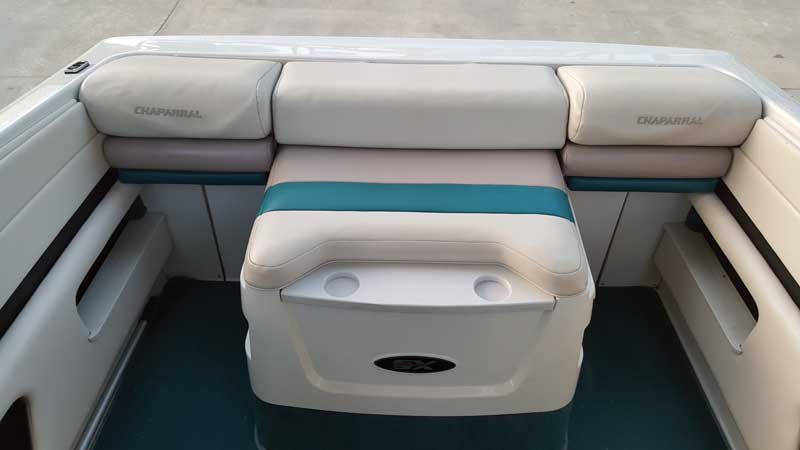
At this point, the reader may be asking: why this hull of all the others out there? The answer is that in addition to a childhood nostalgia for this particular class of vessels—and affinity for classic muscle boats in general—the 2550 SX is both exceptionally sleek and sporty with clean, sharp, and timeless lines, while maintaining a deck and cabin layout that is functional and spacious unlike the typical ‘go-fast’ boat. Additionally, the 2550 SX is both big and capable enough (with its 20-degree deadrise hull) to battle the big water of the sporty Chesapeake Bay, while simultaneously being small and simple enough to transport via trailer and maintain. Having a hull pad for efficient and effortless planing and a very functional but aesthetically pleasing swim platform (that would come in handy if I ever returned to the tropical seas of Florida) were additional considerations.
Arriving to the owner’s home on the scenic banks of Lake Champlain on a cool May afternoon, the 1995 2550 SX, named Grape Expectations as an ode to the nearby vineyards that are a defining feature of the Plattsburgh, NY, area was resting on its OEM teal painted steel trailer under both a full mooring cover and a snap-on cockpit cover. A wonderful sign for someone looking for a well-cared for vessel. Under the covers, it was apparent the boat had been taken care of—albeit a bit dirty from being stored for the last six months. After climbing all over the vessel into every nook and cranny, it was clear that the boat was all original and essentially a time capsule from 1995: for better and worse. It featured the original stereo, VHF radio, snap-in-carpet, upholstery, engine, outdrive, etc. I personally prefer to buy boats that have been unaltered by their previous owners because I have found that most boats that have been altered and/or extensively repaired have been done so in a shoddy manner. On the flip side, this typically means that an all-original 25-year-old vessel will require an extensive refit and litany of modernizations in order to be in ship shape and ready for use.
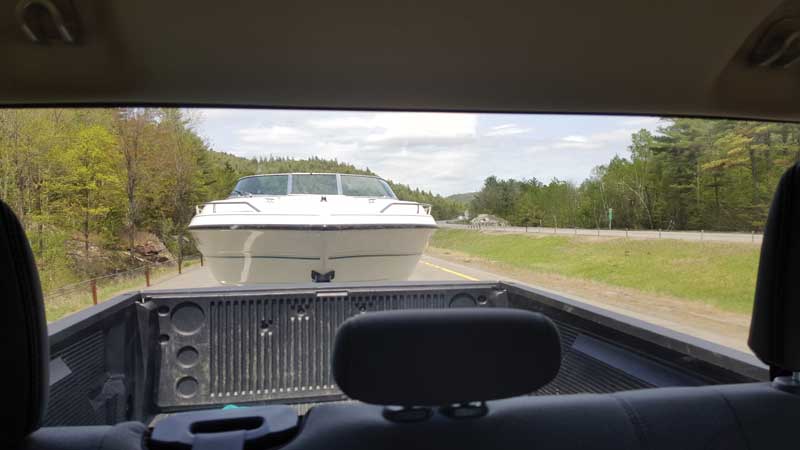
Nonetheless, after carefully inspecting the vessel and thoroughly going through the systems and hull and deck for glaring issues like structural rot, we sea-trialed the vessel with John, the current owner. The sea trial was mostly uneventful, and the boat planed and performed fairly well minus one stall, which I chalked up to bad fuel or a failing mechanical fuel pump. There was, however, an intermittent popping/rattling sound that was audible only under certain throttle positions, which past experience taught me was likely a stuck intake valve which caused a slight backfire through the carburetor under load. With these concerns revealed by the sea trial, we reduced our offer and agreed upon a sum of $14,000 for the boat, trailer, and all accessories.
The trip home with our new boat was long, slow, tedious, and nerve-wracking. Because the trailer had only been used to drive one mile to a nearby boat ramp to launch and retrieve the vessel, the tires were very old and displayed lots of small cracks on the sidewalls and tread. Fortunately, I had purchased a brand new, full size spare tire and wheel for the trek home which came in handy when we had a blowout about four hours into the return journey. After successfully replacing the blown tire on the side of a busy mountain highway in upstate New York, we went exceptionally slowly. A crawling 55 mph was our average speed the rest of the way home to Annapolis. As a result, we arrived at our marina around 4 a.m. when we unhooked the trailer, covered the boat, and returned the truck to the rental agency. Although the boat was now ours, the journey ahead was just beginning.
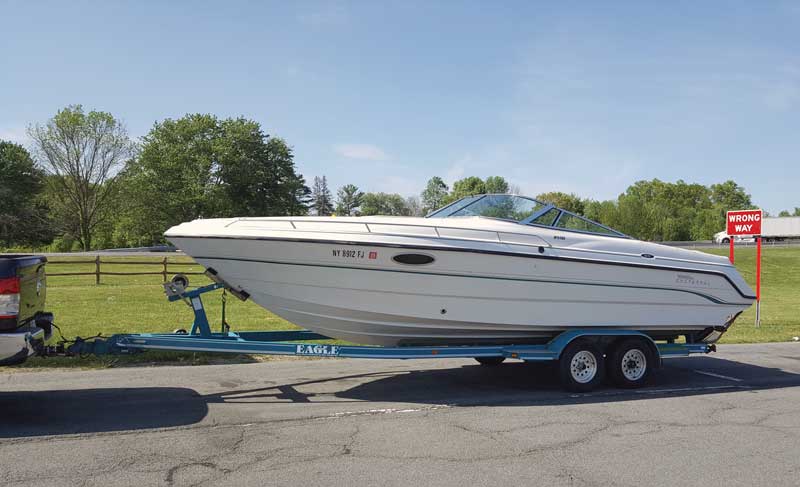
A few days later, after familiarizing myself with the boat and doing some preliminary detailing, we decided to take our new vessel out for a sea trial. After idling out of the marina channel and dropping the throttle, we were met with an incessant and much intensified popping and reverberation sound that had been only intermittent on the sea trial… After a quick call to my best friend, Brandon, who has worked in the past as a marine mechanic, it was clear that the sound was an ominous harbinger of something more serious than a mere sticky intake valve. As a result, the engine would have to come apart so that I could diagnose and fix what was causing the unseemly popping noise that was coming from the top end of our boat’s 7.4L/454 CI petrol V8 Mercruiser (GM) motor. After a few days reprieve, I dug into the motor.
Stay tuned for part II in our January issue where the author will detail his complete top-end engine rebuild.
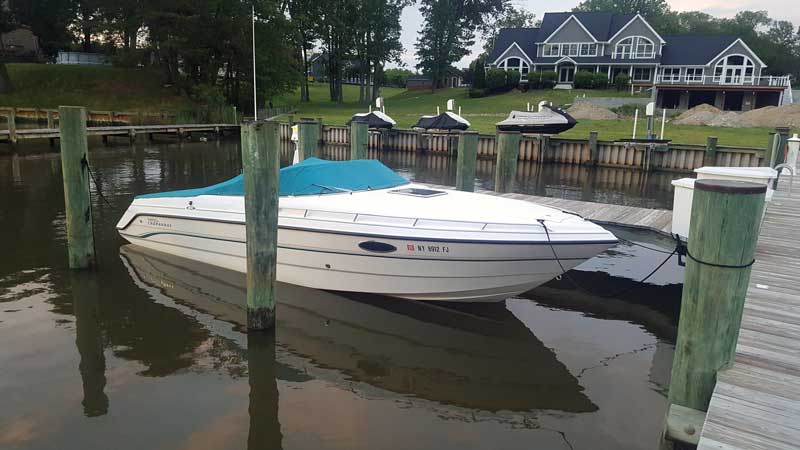
About the Author: Drew Maglio is a writer, marine surveyor, and the owner and operator of Capital Boat Works, a marine repair, detailing, consulting, and training company based in Annapolis, MD. Hailing from South Florida, a love of boating and the ocean was ingrained in Drew from an early age. Drew attended Palm Beach Atlantic University for his B.A. and St. John’s College for his M.A.